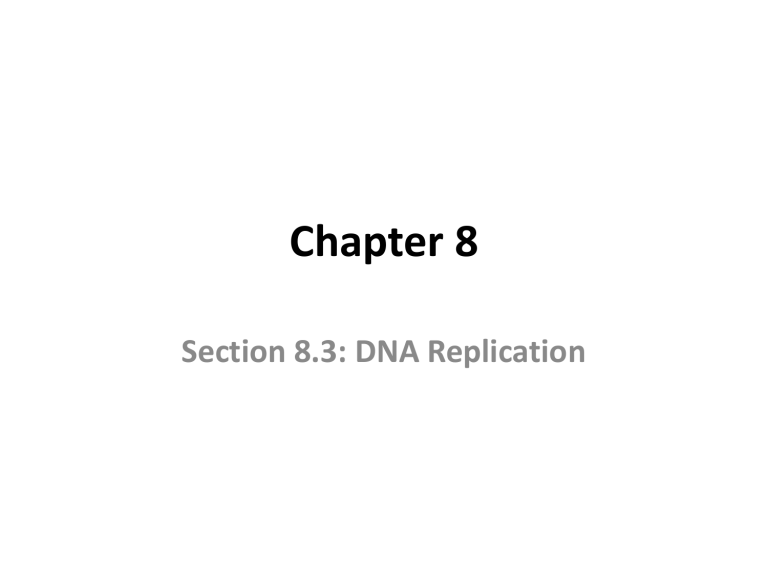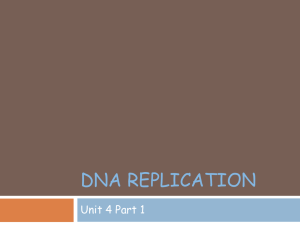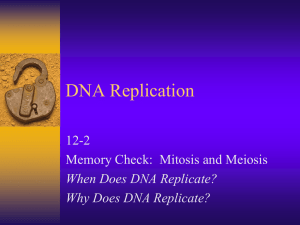Section 8.3: DNA Replication

Chapter 8
Section 8.3: DNA Replication
Objectives
• SWBAT summarize the process of DNA replication.
• SWBAT describe the role of enzymes in DNA replication
Vocabulary
• DNA Replication
• DNA polymerase
• Template
• Review base pairing rules
• S-Phase of Interphase
Templates
• What is a template?
• How are templates used?
• What would a DNA template be and how would it be used?
DNA Replication
• Recall: the nitrogen containing base (known as bases from here on) can pair only in one way.
– Adenine and Thymine (A-T) and
– Guanine and Cytosine (G-C)
– A always has to pair with T (A-T or T-A) and
– C always has to pair with G (C-G or G-C).
– If the sequence of one strand of DNA is known, then automatically you should be able to create
the other strand.
DNA Replication
• A single strand can serve as a template
(pattern) for a new strand.
– In other words, a new strand of DNA is made using an already existing strand.
– The order of the bases are preserved (which is really good since they are your genes)
• The process of creating a new strand of DNA from an already existing strand is known as
DNA replication.
The double helix is unzipped and each existing strand acts as a template to create a new strand and restore the double helix.
DNA Replication
Replication takes place during S-Phase of cell cycle
DNA replication assures that every cell has a complete set of identical genes.
DNA is replicated in each round of the cell cycle.
DNA Polymerases (protein enzymes)
• We might say that DNA replicates itself but that really isn’t true (DNA is only a medium
for storing information).
• DNA polymerases (a class of proteins/enzymes) do the actual replicating.
• Some enzymes start the process by unzipping the DNA double helix creating two template strands.
DNA Polymerases (protein enzymes)
• Other proteins hold the strands of DNA apart while they serve as templates.
• The DNA polymerases take nucleotides floating free in the nucleus and bind them
together.
• When the DNA polymerases are done, the result is two new, identical, DNA molecules.
DNA Polymerases (protein enzymes)
DNA is unzipped by proteins at numerous places along the chromosome.
These places are called the origins of replication
The DNA molecule unzips in both directions.
nucleotide
Unzipping means that the hydrogen bonds that hold the complementary base pairs together are broken. The bases on each strand are exposed.
DNA Polymerases (protein enzymes)
Free floating nucleotides in the nucleus pair, oneby-one, with the complementary bases on the template strands
(forming hydrogen bonds).
DNA polymerases bond the nucleotides together to form new strands that are complementary to the template strand.
DNA Polymerases (protein enzymes) original strand new strand
Two identical molecules
(chromosomes) result from the process.
Two molecules of DNA
Each new double helix has a strand from the original molecule and one that is new. Therefore, we call the DNA replication process semiconservative.
Proofreading
• It is fast, accurate, and occurs in every living thing.
– In human cells, the replication of a chromosome takes just a few hours.
• As DNA is being replicated, DNA polymerase
“proofreads the copy.” Generally errors are caught and corrected.
– Copying errors in germ cells are mutations.
– They are relatively rare – one error per 1 billion nucleotides.
Final Thought
• Your DNA has replicated trillions of times since you grew from a single cell.







